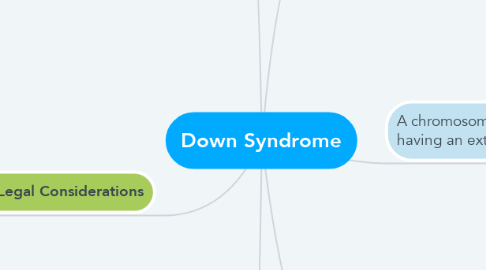
1. Impact on Family
1.1. Possible need for family/ behavioral therapy
1.1.1. Help support parents and family members develop strategies for dealing with disruptive behaviors
1.2. Education for parents and siblings
1.2.1. Parents should be provided with current information on Down syndrome
1.2.1.1. Parents should be provided with local parental support groups and local health service groups
1.3. Can require longer and more intensive care-taking
1.3.1. high stress levels for parents/care-takers
1.4. Medical complications and lower life expectancy
1.4.1. high stress levels for parents/family members
1.4.2. Complex medical needs
1.4.3. Higher risk of: congenital heart defects, gastrointestinal tract defects, vision problems, congenital hearing problems, pathogenic infections, specific blood disorders, obstructive sleep apnea, obesity
2. Assessment Considerations
2.1. Prenatal screening
2.1.1. Prenatal diagnostic testing
2.1.2. blood tests
2.1.3. ultrasound indicators
2.1.4. chorionic villus sampling (CVS)
2.1.4.1. genetically tests fetal cells
2.1.4.1.1. Low risk for fetus
2.2. Karyotype Analysis
2.2.1. Clearly identifies chromosomal abnormality
3. Ethical and Legal Considerations
3.1. Prenatal diagnosis
3.1.1. Termination of pregnancy after positive down syndrome diagnosis
3.2. Gene therapy
3.2.1. deliver a gene to the extra copy of chromosome 21 to directly inactivate it
3.3. Belief in the right to know one's own genetic data
3.3.1. Pregnancy risk analysis
3.3.1.1. Influence on having children in the future
3.3.1.1.1. Possible prejudice towards having a"non-normal"child
3.4. Preimplantation genetic diagnosis (PGD)
3.4.1. Genetic testing of embryonic cells
3.4.1.1. Karyotype analysis can determine which embryos would develop into a child with down syndrome
3.4.1.1.1. These embryos are discarded
3.4.1.1.2. The other embryos are implanted and used to establish pregnancy
4. A chromosomal disorder that results from having an extra number 21 chromosome
4.1. Occurs from nondisjunction during meiosis
4.2. The additional copy of chromosome 21 can cause displacement of other chromosomes
4.2.1. Alters the expression of genes
4.3. Over 600 genes are identified on chromosome 21
4.3.1. chromosome 21 influences almost every tissue in the body
4.3.1.1. Results in broad phenotype displayed in Down Syndrome
5. Common Characteristics
5.1. Intellectual disability
5.2. Congenital heart defects
5.3. Flat faces
5.4. Wide-spaced eyes
5.5. short stature
5.6. low nasal bridge
5.7. poor muscle tone
5.8. epicanthal folds
6. Scope of Nursing Practice
6.1. Highly individualized care plans
6.1.1. Focus on patient-specific issues
6.1.1.1. Manage acute and chronic complications
6.1.1.2. Reduce risk of complications
6.2. Physical Assessments
6.3. Documenting growth and development
6.3.1. Working closely with physicians and parents to assess, support and encourage development
6.4. Promoting a healthy lifestyle
6.5. Providing education for families
6.5.1. emotional support
6.5.2. encouragement of family's participation in plan of care for reaching desired outcomes
